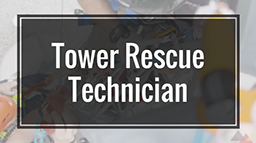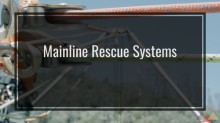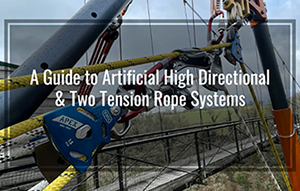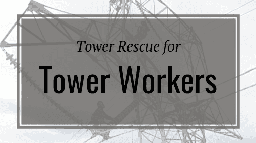Learn what it takes to become fully equipped to carry out the demanding types of high angle rescues.
About the Course
Across the country “tower” type rescues are becoming more and more common. Accordingly, there is a growing need for local rescuers to be aware of these sites in their response areas, pre-plan for different rescue scenarios, and train their specialized rescue personnel to the appropriate level to facilitate the rescue in a safe manner.
Tower rescues have become so prevalent, that when the NFPA published the latest version of the 1670 standard, it included Tower Rescue Awareness, Operations, and Technician level requirements. Still, the big question for all of us who work in high angle rescue is, “how many departments and rescue teams across the country are truly trained and equipped to carry out these demanding types of rescues?” The first thing we need to define when talking about tower rescue is the tower itself. What exactly is a tower?
Nathan Paulsberg, an instructor you’ll see a lot of inside this course, currently serves as a Lieutenant for Palatine Fire Department, located in the Chicagoland area. He is a member of Palatine’s Technical Rescue Team and the head of MABAS Division 1’s Technical Rescue Training Committee. Instructor for technical rescue classes at the Northern Illinois Public Safety Training Academy and Gateway Technical College. Squad officer and head of rope operations for Illinois Task Force 1. Co-owner of Elevated Safety, and SPRAT level 3 Rope Technician.
What You’ll Learn
1. “Bottom-up” style rescues
2. “Top-down” style rescues
3. Tower Control versus Ground Control
4. And more!
Course Curriculum
Unit 1: Welcome
1.1 Welcome
1.2 Course Material
1.3 Elevated Safety Tower Rescue Technician Resource Manual
1.4 Tower Rescue Standards Brief NFPA 1670-2500
1.5 Size Up – Type of Tower Structures
1.6 Action Plan – Tower Emergencies
1.7 Incident Plan – Tower Emergencies
1.8 Rigging Guide – Tag Line System
1.9 Rigging Guide – Guide Line System
1.10 Rigging Guide – Skate Blocks
1.11 Rigging Guide – Tracking Line System
1.12 Rigging Guide – Tracking Skate Block (Hybrid)
1.13 Tower Emergencies
Unit 2: Tag Line System
2.1 Tag Line System
2.2 Video Tutorial: Tower Rescue Tower Control Tag Line
2.3 Quiz: Tag Line System
Unit 3: Guide Line System
3.1 Guiding Line System
3.2 Video Tutorial: Tower Rescue Tower Control Guide Line
3.3 Quiz: Guide Line System
Unit 4: Skate Blocks
4.1 Skate Blocks
4.2 Video Tutorial: Tower Rescue Ground Control Twin Tension Skate Block
4.3 Quiz: Skate Blocks
Unit 5: Skate Block Anchors
5.1 Skate Block Anchors
5.2 Video Tutorial: Tower Rescue Tracking Skate Block (Hybrid) Ground Anchor
5.3 Quiz: Skate Block Anchors
Unit 6: Skate Block Patient Connection
6.1 Skate Block Patient Connection
6.2 Video Tutorial: Tower Rescue Hybrid Skate Block Patient Connection
6.3 Quiz: Skate Block Patient Connection
Unit 7: Tracking Line System
7.1 Tracking Line System
7.2 Video Tutorial: Tower Rescue Tower Control Twin Tracking Lines
7.4 Quiz: Tracking Line System
Unit 8: Tracking Skate Block (Hybrid)
8.1 Tracking Skate Block (Hybrid)
8.2 Video Tutorial: Tower Rescue Tracking Skate Block (Hybrid) System
8.3 Video Tutorial: Tower Rescue Tracking Skate Block (Hybrid) Patient Connection
8.4 Quiz: Tracking Skate Block (Hybrid)
Unit 9: Pick Off
9.1 Pick Off
9.2 Video Tutorial: Tower Rescue Pick Off
9.3 Quiz: Pick Off
Unit 10: Gathering Information
10.1 Gathering Information
10.2 Quiz: Gathering Information
Unit 11: Controlling the Site
11.1 Controlling the Site
11.2 Quiz: Controlling the Site
Unit 12: Access
12.1 Access
Unit 13: Tower Control Versus Ground Control
13.1 Tower Control Versus Ground Control
13.2 Quiz: Tower Control Versus Ground Control
Unit 14: Patient Packaging
14.1 Patient Packaging
Unit 15: Wrap Up
15.1 Wrap Up
Unit 16: Bonus Video
16.1 Elevated Safety Bonus Video
Added Perks
Additional features Rigging Lab Academy Members are enjoying
Certificate of Completion
Download your personalized Certificate of Completion after completing the course.
100% Self-Paced
Go through the course material as fast or as slow as you’d like.
Private Discussion Board
Ask questions, meet other students, and even chat with the course instructor.





